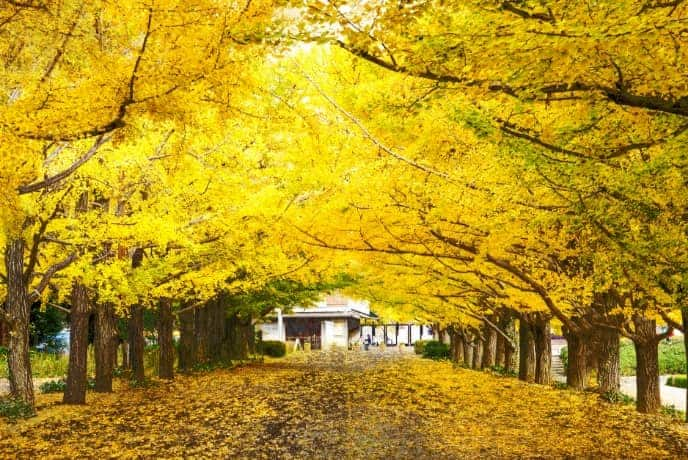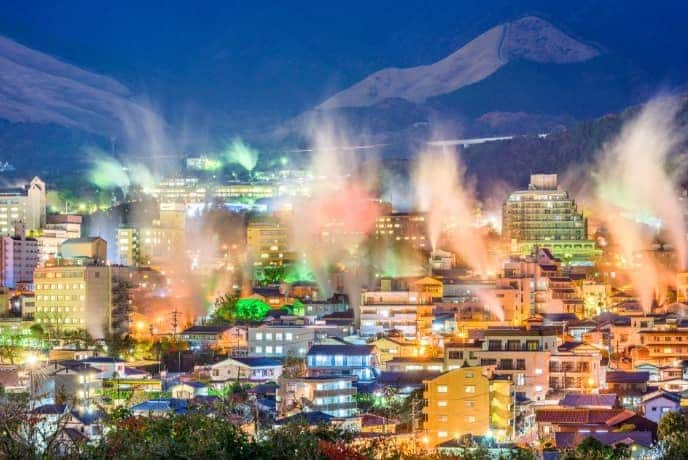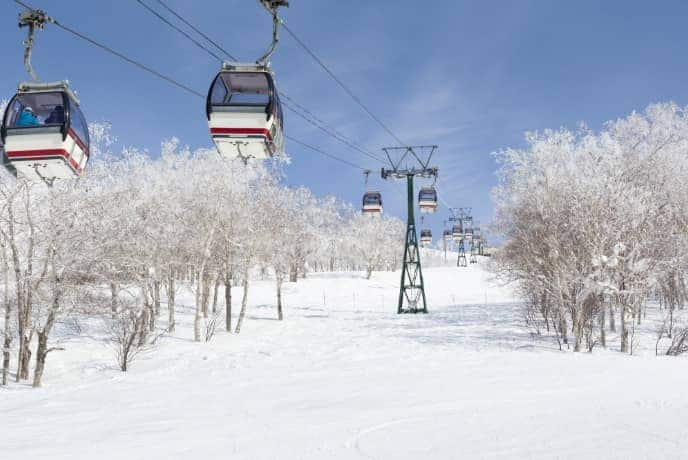How to Enjoy
Japan’s Unique Seasonality
Experience All Four Seasons in Japan
Japan is well-admired for its four distinct seasons. From the cherry blossoms of spring and the lush greenery of summer, to the vibrant autumn foliage and the snowy winter landscapes, you can truly experience the beauty of nature all year round.
Japan also offers an endless variety of experiences that vary with the seasons, including festivals and gourmet delights. In different regions, you will enjoy different seasonal offerings, even within the same month – making Japan an ideal destination throughout the year. Begin your memorable journey to Japan when you embark with ANA today.

Hokkaido is located at the northernmost tip of the Japanese archipelago.
It's the last place in Japan to welcome spring, allowing you to enjoy cherry blossoms even in May. It is also the only region without the rainy season, making its summers refreshing and pleasant. Being the first to experience winter, Hokkaido provides an extended season for snowy landscapes and winter activities. These unique characteristics make Hokkaido one of Japan’s most popular destinations.
Icon details
-
Cherry blossoms
-
Stargazing
-
Lavender viewing
-
Hydrangeas
-
Autumn foliage
-
Snow
-
Snowy Mt. Fuji landscape
-
Tateyama Kurobe Alpine Route's ‘Snow Walls’
-
Penguin walks at Asahiyama Zoo
-
Sea turtles laying eggs
-
Whale-watcing
-
Swimming at the beach
-
Fireworks
-
Sapporo Odori Beer Garden
-
Trekking / Hiking
-
Surfing
-
Diving / Snorkeling
-
Camping
-
Rafting
-
Golfing
-
Skiing / Summer skiing
-
Hot springs
-
Illuminations
-
Apples
-
Strawberries
-
White shrimp
-
Yubari Melons
-
Cherries
-
Peaches
-
Pineapples
-
Mangoes
-
Sake
-
Shine Muscat grapes
-
Soba noodles
-
Hot pot dishes
-
Tuna
-
Crab dishes
-
Festivals

- The average temperatures are based on the Japan Meteorological Agency's data for Sapporo City in 2022.
- Festival schedules, average temperatures, and peak times may vary from year to year. For more details, please check respective websites and other sources.

Besides Hokkaido, Tohoku and Hokuriku regions are also known as ‘snow countries.
The ‘snow walls’ here that reach heights of up to 8 meters are truly spectacular. In the summer, these areas host famous festivals that draw people from all over, creating a lively atmosphere. They are also known for their bountiful source of agricultural produce, offering delicious cuisine throughout every season.
Icon details
-
Cherry blossoms
-
Stargazing
-
Lavender viewing
-
Hydrangeas
-
Autumn foliage
-
Snow
-
Snowy Mt. Fuji landscape
-
Tateyama Kurobe Alpine Route's ‘Snow Walls’
-
Penguin walks at Asahiyama Zoo
-
Sea turtles laying eggs
-
Whale-watcing
-
Swimming at the beach
-
Fireworks
-
Sapporo Odori Beer Garden
-
Trekking / Hiking
-
Surfing
-
Diving / Snorkeling
-
Camping
-
Rafting
-
Golfing
-
Skiing / Summer skiing
-
Hot springs
-
Illuminations
-
Apples
-
Strawberries
-
White shrimp
-
Yubari Melons
-
Cherries
-
Peaches
-
Pineapples
-
Mangoes
-
Sake
-
Shine Muscat grapes
-
Soba noodles
-
Hot pot dishes
-
Tuna
-
Crab dishes
-
Festivals

- The average temperatures are based on the Japan Meteorological Agency's data for Kanazawa City in 2022.
- Festival schedules, average temperatures, and peak times may vary from year to year. For more details, please check respective websites and other sources.

The vibrant capital, Tokyo, the culturally-rich Kyoto, and the gourmet paradise, Fukuoka, are cities that are constantly bustling with tourists and business activities.
In summer, you can expect an even livelier atmosphere with a host of dazzling fireworks festivals. In winter, enjoy the rare occurrence of snow and sparkling cityscapes illuminated with vibrant lights, without having to worry about the weather.
Icon details
-
Cherry blossoms
-
Stargazing
-
Lavender viewing
-
Hydrangeas
-
Autumn foliage
-
Snow
-
Snowy Mt. Fuji landscape
-
Tateyama Kurobe Alpine Route's ‘Snow Walls’
-
Penguin walks at Asahiyama Zoo
-
Sea turtles laying eggs
-
Whale-watcing
-
Swimming at the beach
-
Fireworks
-
Sapporo Odori Beer Garden
-
Trekking / Hiking
-
Surfing
-
Diving / Snorkeling
-
Camping
-
Rafting
-
Golfing
-
Skiing / Summer skiing
-
Hot springs
-
Illuminations
-
Apples
-
Strawberries
-
White shrimp
-
Yubari Melons
-
Cherries
-
Peaches
-
Pineapples
-
Mangoes
-
Sake
-
Shine Muscat grapes
-
Soba noodles
-
Hot pot dishes
-
Tuna
-
Crab dishes
-
Festivals

- The average temperatures are based on the Japan Meteorological Agency's data for Tokyo in 2022.
- Festival schedules, average temperatures, and peak times may vary from year to year. For more details, please check respective websites and other sources.

Situated at the southernmost point, Okinawa is the only part of Japan with a subtropical climate.
Being the very first to welcome spring, Okinawa’s unique cherry blossoms bloom proudly in January. While March to November’s comfortable weather lets you enjoy a variety of water sports. Be mesmerized by its beautiful emerald-green sea, extensive coral reefs and smooth, white sandy beaches.
Icon details
-
Cherry blossoms
-
Stargazing
-
Lavender viewing
-
Hydrangeas
-
Autumn foliage
-
Snow
-
Snowy Mt. Fuji landscape
-
Tateyama Kurobe Alpine Route's ‘Snow Walls’
-
Penguin walks at Asahiyama Zoo
-
Sea turtles laying eggs
-
Whale-watcing
-
Swimming at the beach
-
Fireworks
-
Sapporo Odori Beer Garden
-
Trekking / Hiking
-
Surfing
-
Diving / Snorkeling
-
Camping
-
Rafting
-
Golfing
-
Skiing / Summer skiing
-
Hot springs
-
Illuminations
-
Apples
-
Strawberries
-
White shrimp
-
Yubari Melons
-
Cherries
-
Peaches
-
Pineapples
-
Mangoes
-
Sake
-
Shine Muscat grapes
-
Soba noodles
-
Hot pot dishes
-
Tuna
-
Crab dishes
-
Festivals

- The average temperatures are based on the Japan Meteorological Agency's data for Naha City in 2022.
- Festival schedules, average temperatures, and peak times may vary from year to year. For more details, please check respective websites and other sources.
Spring

Spring is generally from March to May in Japan. “Sakura” or cherry blossoms are a symbol of spring in Japan. Many people gather under sakura trees for “ohanami,” which means cherry blossom viewing, all over Japan. Japan geographically stretches from north to south, and sakura starts blossoming in the south in late March then moves its way up to the north. Hokkaido, located in the north of Japan welcomes full blossoms in May. Spring is a mild season suitable for various leisurely activities.
数多くある桜の名所の中でも、桜と富士山という日本のシンボリックな風景は、国内外から多くの人気を集めます。他にもお城と桜を一度に見れる、姫路城や弘前公園の景色も絶景です。
Wisteria, moss phlox and many other types of flowers other than sakura also bloom in the spring. These flowers become a tourist attraction but they are also is there as a guided path.
Summer
Summer is usually from June to August. Japan is surrounded by the sea, so you can enjoy swimming in various places. You can swim in the sea near Tokyo, but remote the islands of Okinawa are also recommended to enjoy a relaxing time.
Once the rainy season called “tsuyu”, which lasts from June to late July is over, the temperature rapidly increases. This is the season for summer festivals and firework displays happening everywhere in Japan. You can enjoy watching festivals or take part in dancing at other festivals as well.
Autumn
September to November is usually the fall season. The heat of summer eases, and the most comfortable and nicest weather comes in this season. The peak for leaves changing colors is from October to late November. Mountains in Hokkaido start to turn color, and colors of leaves gradually change from the north down to the south of Japan. Visit tourist attractions anywhere in Japan that are famous for leaves changing colors and delight in the beauty.
Fall is also best for outdoor sports and leisurely activities. Seasonal foods, rich in nutrition and flavor, in other words, "the fall that makes you hungry", are also something worth tasting.
Winter
Winter is from December to February. It is the coldest season of the year, which is perfect for enjoying hot springs. Dipping in a hot spring while relishing in the beautiful winter scenery is exceptionally remarkable. Illumination events are held all over Japan toward the year-end.
Drift ice and snowy landscape representing dazzling winter are not to be missed. Skiing and dog sledding are also an amusing leisurely activity of winter.
Choose
Your Next
Destination
Seasonal
Recommendations
-
Spring

Spring Flower-Viewing in Hokkaido
Cherry blossom fort and night views of Hakodate
Make the most of spring in Hokkaido proud of its cherry blossoms.
-
Summer

Summer in Hokkaido
Kushiro Wetlands and Shiretoko Five Lakes
Feel the majestic wilderness. Touring northeast Hokkaido in the summer.
-
Autumn

Must-See in Kansai
Unesco World Heritage Sites in Kyoto and Nara
Ancient cities in Japan: Kyoto and Nara. Visit the classic locations in Japan.
-
Winter

Winter in Tohoku
Zao, Ginzan Onsen, and Sendai Gourmet
Experience the history and beauty of nature with this itinerary that brings you to Yamagata Prefecture and Miyagi Prefecture from Sendai Airport.



























